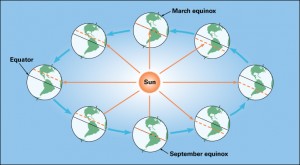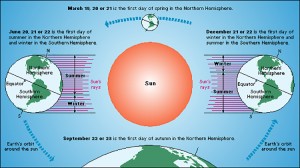The September Equinox
Friday, September 22nd, 2017September 22, 2017
Today, at 4:02 p.m. Eastern Time, the autumnal equinox marks the beginning of autumn in the Northern Hemisphere. In the Southern Hemisphere, where the seasons are reversed, the event is called the vernal equinox and marks the start of spring. The word vernal means of spring. An equinox is either of the two moments each year (the other is in March, again changing the seasons) when the sun is directly above Earth’s equator. On the days of the equinoxes, all places on Earth receive approximately 12 hours of sunlight. Today, the sun rose at 6:43 a.m. Eastern Time and will set at 6:52 p.m.—a total of 12 hours and 9 minutes of daylight. The term equinox comes from a Latin word meaning equal night. The equinoxes occur at different times of day each year on March 19, 20, or 21 and on September 22 or 23.

The equinoxes are the two moments of the year when the sun is directly above the equator. As Earth moves in its orbit around the sun, the position of the sun changes in relation to the equator, as shown by the dotted lines in this diagram. The sun appears north of the equator between the March equinox and the September equinox. It is south of the equator between the September equinox and the next March equinox. Credit: WORLD BOOK diagram
The time interval from the March equinox to the September equinox is longer than that between the September equinox and the next March equinox. This time difference results from the Earth’s elliptical (oval-shaped) orbit around the sun. Our planet moves faster in its orbit when it is closer to the sun. The distance between the Earth and the sun is shortest in January. Therefore, the Earth completes the semicircle from the September equinox to the March equinox faster than it does the opposite semicircle.
Astronomers also use the term equinox for either of two imaginary points where the sun’s apparent path among the stars crosses the celestial equator. The celestial equator is an imaginary line through the sky directly over the equator.
After the autumnal equinox, the weather cools and nights become longer than days, and days continue to shorten until the winter solstice. The weather then warms and daylight begins its recovery toward the summer solstice in June. The winter solstice is technically the shortest day of the year, and the day of the summer solstice enjoys the most sunlight.




